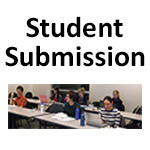No examination of the role of information in public policy development is complete without a discussion of the science-policy interface. This post will outline defining characteristics of the interface, and issues and difficulties surrounding its functionality.
First, what is meant by the science-policy interface? Essentially, this term refers to the interplay between scientific research and information on the one hand, and policy development on the other. Scientific research is conducted by trained scientists, usually specialists in their fields, while policies are developed by politicians or civil servants, often without scientific backgrounds. Scholars such as Sybille van den Hove argue for the intrinsic interconnectedness of science and policy, writing that “scientific knowledge is a very common ingredient of policy making, and science is often called upon to provide solutions to societal problems” (van den Hove, 2007, p. 809). Other writers, however, focus on the uneasy relationship between the two fields. Roland Schenkel states that “science is just one important consideration on the table when decision-makers have to make choices…there continues to be tension between scientific information and societal and political priorities” (Schenkel, 2010, p. 1749). Robert Watson agrees, particularly when it comes to environmental policy making. He writes that “politicians are rarely elected for protecting the environment, but rather for what they do to improve the economy, human security and human health” (Watson, 2004, p. 471). Due to the interconnectedness of science and policy, and the tensions that affect the interface, fostering clear and open communication among all stakeholders is needed, including scientists, policy-makers, a wide-range of organizations, industry, and the public.
Some of the tensions in the science-policy interface stem from public perceptions, or from the nature of scientific research itself. The complexity of scientific research is often difficult to communicate to a lay audience. Misunderstandings or apparent uncertainty in scientific research results can undermine public trust in scientists, and the policies built on scientific research (Rapley, 2012). Especially where varied scientific evidence exists, e.g., health-sensitive issues such as the use of genetically modified organisms, public sensationalism can result. The absence of global coordination in the scientific community can lead to research gaps, as seen in the case of the volcanic eruption in Iceland in 2010. In that event, unavailability of information about the effects of ash in plane engines led to the adoption of Europe-wide no-flight policies (Schenkel, 2011), which affected travellers worldwide.
Moral and ideological considerations also complicate the science-policy interface. Despite modern science’s goal of objectivity, research is conducted by individuals. Each researcher brings his or her own thoughts, experiences, and morals to bear on the scientific conclusions reached. While policy-makers ostensibly seek “conclusions [that are] evidence-based and not value-laden” (Watson, 2005, p. 474), it is arguable whether or not such conclusions can exist.
In order to foster effective communication at the science-policy interface, scientists and policy-makers often need to choose whether to give priority to issue-driven or curiosity-driven science. Generally, issue-driven science refers to research undertaken to address specific problems, while curiosity-driven science can be understood as knowledge-seeking for its own sake (van den Hove, 2007). Issue-driven research may appear more expedient for policy-development. However, knowledge gained through curiosity-driven research can also be crucially informative to policies, and provide an invaluable information-base for the future.
Most important to the science-policy interface is the question of where the responsibility of knowledge-transfer lies. Robert Watson places the onus on scientists, stating that the only way policy-makers are going to heed scientific research is if scientists explicitly link their findings “to the development issues that policy-makers and the majority of the general public care about” (Watson, 2005, p. 471). On the other hand, policy-makers may be seen as responsible for incorporating scientific research into their policy statements (Schenkel, 2011). A third possibility, propounded by van den Hove (2007), is for social scientists to act as mediators in the science-policy interface, thereby taking on much of the responsibility for the activity at the interface.
Wherever responsibility lies for fostering effective knowledge transfer in the science-policy, development and promotion of communication between all stakeholders is critical. Sweden’s adoption of nuclear power, for instance, decided after extensive public consultations and engagement from scientists and policy-makers alike, may be seen as an example of the science-policy interface functioning well (Schenkel, 2011).
Authors: Vanja Avdic and Danielle Hubbard
References
Briggs, S. V., & Knight, A. T. (2011). Science-policy interface: Scientific input limited. Science, 333, 696-697.
Rapley, C. (2012). Time to raft up. Nature, 488, (583-585).
Schenkel, R. (2010). The challenge of feeding scientific advice into policy making. Science, 330,1749-1751.
van den Hove, S. (2007). A rationale for science-policy interfaces. Futures, 39(7), 807-826.
Watson, R. T. (2005). Turning science into policy: Challenges and experiences from the science-
policy interface. Philosophical Transactions of the Royal Society B: Biological Sciences, 360(1454), 471.
This blog post is part of a series of posts authored by students in the new graduate course, “The Role of Information in Public Policy and Decision Making,” offered at Dalhousie University.
